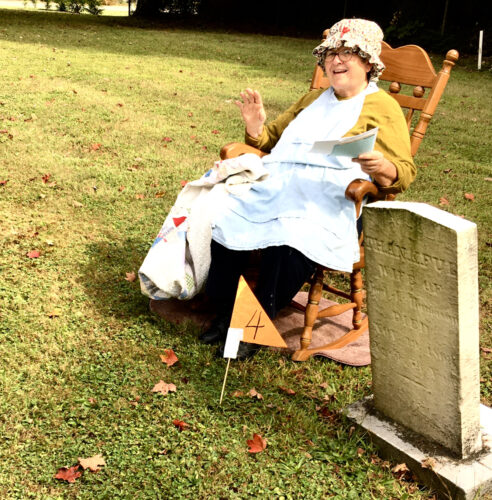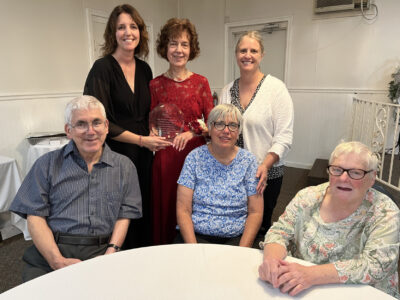Cemetery tour alive with history

Correspondent photo / Sean Barron
ABOVE: Arlo Sirochman, dressed as Thankful Ford Humason, shares information about the Humason family, who settled in the area from Connecticut in the 1800s during a walk through Paynes Corners Cemetery on Saturday in Brookfield.
“I am not sure what exact route they took, but the most popular way from Connecticut was to walk across New Jersey to Philadelphia, then to Pittsburgh and to Youngstown and Warren. This trip took about five or six weeks,” Marilyn Lees-Yensick of the Brookfield Historical Society, said.
En route to the Vienna and Brookfield areas in 1804, Timothy and Ruth Alderman often carried their five children and meager belongings in an oxcart, and they walked part of the way. At night, they usually slept in the cart or on the ground before arriving in Trumbull County, she added.
The Aldermans were among four families who traveled in the early and mid-19th century mainly from Connecticut to settle in the area. They also were discussed during a series of walks Saturday afternoon through Paynes Corners Cemetery off Warner Road SE.
The Brookfield Historical Society hosted the two-hour series of walks.
The draw for Timothy Alderman and his large family to make the arduous trip was a chance to buy land in Brookfield, which was part of the Connecticut Western Reserve. Since Alderman was a veteran who had served in the Continental Army during the Revolutionary War, he was given that opportunity, Lees-Yensick noted.
Shortly before and after Alderman’s death in 1814, his wife and their four daughters enlarged the family farm off what is now Warner Road and grew flax to make clothing. According to records, the family sold 100 yards of cloth for 50 cents per yard for soldiers who fought in the War of 1812, she said, adding that 13 Alderman family members are buried in the cemetery.
Despite desirable farmland, the family had few amenities primarily because “trade with the outside world was almost nonexistent,” Lees-Yensick said.
“The Aldermans had to be self-sufficient, growing everything that they needed and relying on each other and a few neighbors for assistance,” she added.
Also traveling a considerable distance in the 1800s from New England to Trumbull County was Ichabod B. Payne and his wife, Betsey J. Payne, who helped establish the area’s first apple orchard. They bought a farm, and he became a prominent figure in political and civic matters, Deb Filipovich of the historical society, noted.
Specifically, Ichabod Payne, who “paid close attention to public affairs,” was a teacher and a farmer, then served as a Vienna Township official and Trumbull County commissioner, she said.
In addition, he contributed money and time to the Union cause during the Civil War, Filipovich noted.
“He left a legacy of an honorable life,” she said.
The same year Ohio became a state in 1803, Alfred Wheeler and his wife, Sabra A. Wheeler, arrived from Connecticut after having struggled with a land shortage there, Barbara Stevens, the historical society’s president, noted.
The couple raised six children, including son Earl Wheeler, who became prominent in the iron industry. In 1862, the younger Wheeler began the Wheeler Iron Co. in West Middlesex, Pa., she said.
Also discussed were Joel J. Humason Jr. and his wife, Thankful Ford Humason, the latter of whom arrived in Vienna Township in 1801 at age 11 from Farmington, Connecticut, with her father, Thomas Ford. In addition, her father-in-law, Joel J. Humason Sr., also from Connecticut, was a veteran who had enlisted in 1775 to fight in the Revolutionary War, Arlo Sirochman, a historical society member who dressed as Thankful Ford Humason, said.
Thankful Humason’s in-laws and their children were among Vienna’s earliest settlers, having arrived between 1800 and 1803, Sirochman noted.
A few family members also established a few firsts in the area.
“The first frame house was built by Isaac Humason, Joel Sr.’s brother, in about 1804. The first frame building was a barn erected by Joel Humason Sr., she said.
On April 7, 1806, Vienna Township’s first government was established, with Joel Humason Sr. elected as supervisor and Isaac Humason as a constable, Sirochman noted.
In addition, Joel Humason served in the 3rd Regiment of the Ohio Militia during the War of 1812, she said, adding that he also was likely sent to the Battle of Marblehead Peninsula on Sept. 29, 1812, which was the war’s first battle on Ohio soil.
The skirmish ended in a draw after 130 Native Americans ambushed about 60 American militia members, which resulted in the death of eight Americans and 30 to 40 Native Americans.
Also discussed as part of the gathering Saturday was the history of Paynes Corners Christian Church, which is on cemetery property. The one-story church opened after the deed for the lot had been signed Oct. 2, 1858, and it was built for $1,000. It also had 50 charter members, Jan Arnaut, event coordinator and the historical society’s vice president, explained.
In 1900, the structure underwent remodeling, though Sunday services continued in the schoolhouse. In 1973, new siding was added to the building, which was the original structure, Arnaut said, adding that before its establishment, nearby residents had to travel several miles via horseback each Sunday to Vienna Center or Brookfield.

